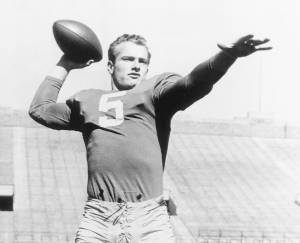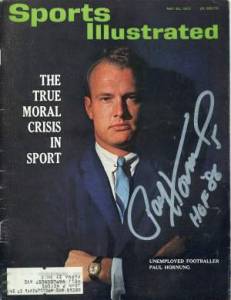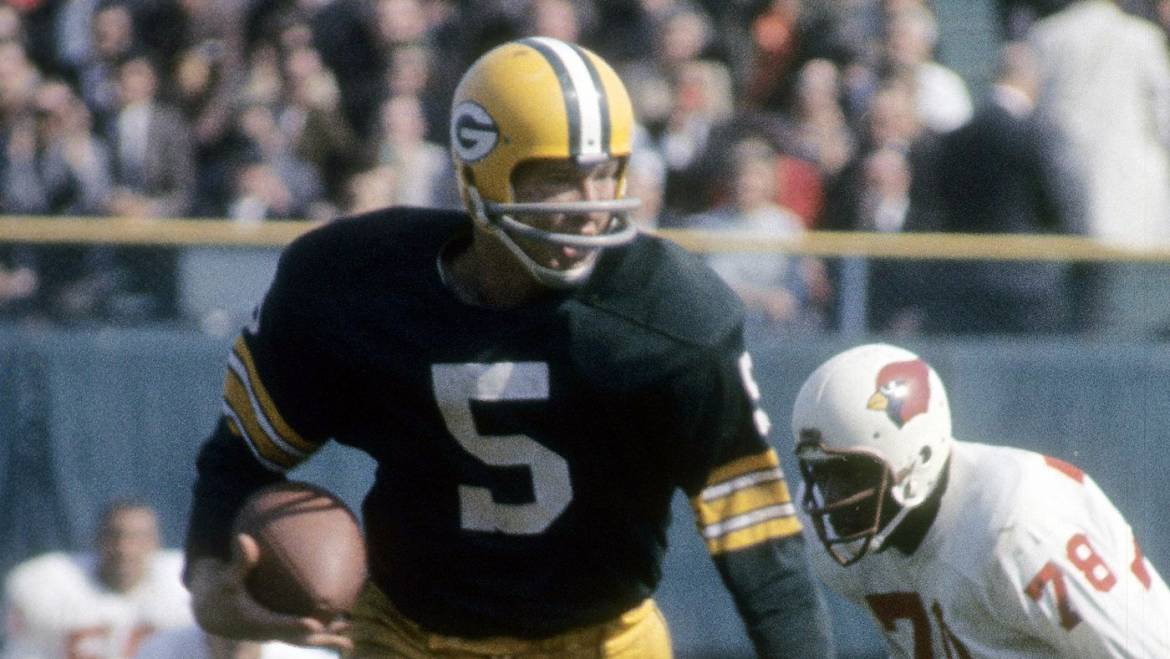I have been called sports-obsessed more than once, but really it’s not true. While I appreciate athletic competition and excellence, I do not live and die with it. In fact, I feel pity and a measure of scorn for those people whose lives are wrapped around their favorite teams and players—regardless of the sport. More and more these days, I find peripheral sports stories more interesting than the daily fluff of Sports Illustrated and ESPN. I am under no illusion that my Texas Longhorns, Dallas Cowboys, and so on are better, worthier or more virtuous than their adversaries.
Paul, Eddie and Elgin
One thing I certainly don’t do anymore is engage in hero worship. Idolize a jock? Not me. Most of these guys are not very interesting or admirable people. There was a time when I did, however. Just as I picked Eddie Mathews and Elgin Baylor as my favorite baseball and basketball players, respectively, I liked Paul Hornung in football. Matthews, Baylor and Hornung were all chosen in the early 1960s, when I was about 10 years old and impressionable.
So I will now indulge myself by recalling Hornung, and his exploits on and off the gridiron. He was born in 1935 in Louisville, Kentucky and was heavily recruited out of a Catholic high school. Hornung ended up going to Notre Dame where he was a second-string player his sophomore year. (This was before frosh were allowed to play on the varsity.) But he did not sit on the bench any more for the Irish. Taking football versatility to ridiculous lengths, he played quarterback, halfback and defensive back. Hornung also returned punts and kickoffs, and was the team’s kicker.
He stuns the Hawkeyes
One of his greatest collegiate games came on November 19, 1955 against Iowa in South Bend. The Hawkeyes had just gone up 14-7 with 10 minutes to play. He returned the kickoff 38 yards and completed three passes, including a TD strike in the corner of the end zone. He kicked an extra point to tie the game and then was part of the defensive stop. Hornung led a Notre Dame drive that culminated with him kicking a field goal as time expired before his teammates and other students lifted him up on their shoulders. In 1956, he won the Heisman Trophy despite the Irish going just 2-8. If there has ever been a better example of Notre Dame getting preferential treatment from the media, I would like to see it.
He was blond, handsome, quotable and a superb football player. For all these reasons, the Green Bay Packers spent a first-round draft choice on Hornung. He did not set the NFL on fire his first two seasons, but everything changed when Vince Lombardi was hired in 1959. The Pack became one of the league’s top teams, winning championships in 1961, 1962, 1965 and 1966. Of all the fine players on those Green Bay teams—Bart Starr, Jim Taylor, Dave Robinson, Forrest Gregg, Ray Nitschke, Herb Adderley and Willie Davis, for example—Hornung was the key. He no longer played defense or returned kicks, but he was a gifted running back, receiver and kicker. He was at his best in the 1960 season when he scored an NFL-record 176 points by making 15 touchdowns, and kicking 15 field goals and 41 extra points. He also threw for two TDs. Note: he did this when the league played just 12 regular season games.
Busted for gambling
I really enjoyed watching Hornung wear the green and gold. He was widely recognized as one of the NFL’s best players in the early 1960s. However, what you will not find on his personal website is any reference to the 1963 season. That’s because he did not play that year, having been suspended (along with Alex Karras of the Detroit Lions) for gambling and associating with undesirable characters. He came back from such a humbling affair and showed he could still play; in 1965, in a 42-27 defeat of the Baltimore Colts, Hornung scored five touchdowns.
It took him nearly 20 years to get elected to the Pro Football Hall of Fame, and I have to think 1963 had something to do with it. At any rate, he enjoyed a sterling career at Notre Dame and Green Bay. He stood 6’ 2’’, weighed 210 pounds and was considered fast for that era. Would he get a shot today? I wonder, because European-American running backs are about as common as a three-dollar bill.


Add Comment